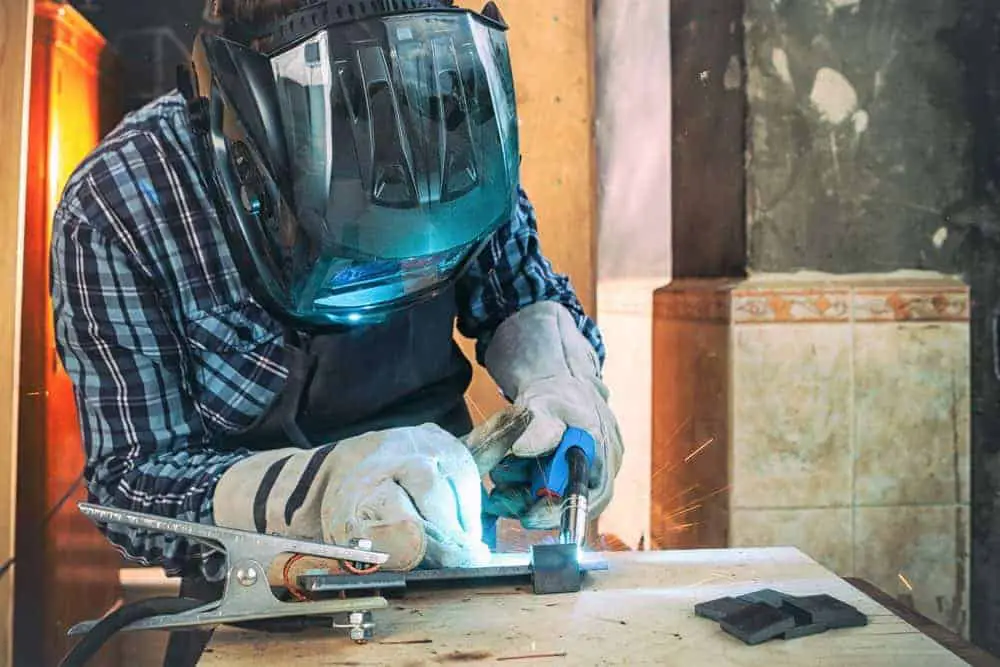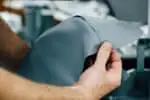If you’re a welder, someone must have surely advised you on starching your clothes. Starching of clothes has been going on since ages, and it is a process to keep your clothes sharp and crisp.
But you must be wondering why welders need to keep their shirts crisp. It is not only because of the crispness starching does to your clothing, but because of safety reasons too.
Welders prefer to starch their clothes, especially shirts, because it decreases the amount of damage it does to their garments and, eventually, their skin. The starch acts as a protective barrier, extending the garment’s durability.
Now let us understand the benefits of starching your welding shirts-
1.) Starch prevents dust from sticking to your shirt. When dirt accumulates on a starched fabric, it is readily washed away and does less harm to the clothing.
2.) By sealing the individual garment fibres, starch protects the fabric from stains.
3.) Properly starching your clothes helps prevent slag, sparks, and splatter from infiltrating your garments. As a result, you will avoid having skin burns.
4.) It can protect items that cannot be washed with water. Typically, your welding shirt may be worn two or three times before it has to be dry cleaned.
5.) Welders don’t only starch their shirts for function. When garments are starched, they become pleasant and crisp, as well as wrinkle-free. This facilitates ironing and protects the material from severe stains.
How does starch help to protect your shirt?
When you correctly starch your clothes, you prevent slag and spatters from passing through the fabric. If you don’t know, most welding burns may be up to third-degree burns, however, if your shirt is properly starched, it can help protect your skin.
Starch’s qualities work as a flame retardant and prevent dirt and debris from adhering to your garments. Although starching does not turn your shirt into a full-fledged flame-retardant fabric, it helps extend the life of your clothes when compared to the original.
Wearing starched garments takes some getting used to, you may not enjoy the feeling at first or may not get used to it at all because it requires breaking in as starched clothes are usually stiff.
Can you starch your welding clothes at home?
Yes you can. With starch and a good ironing method, you can easily starch your welding clothes at home. For optimal results, iron the shirt when it is still somewhat moist.
What you’ll need-
-
-
- Ironing board
- Iron
- Spray starch
- Bowl
- Hanger
-
Tips on how to starch your welding shirts at home
1.) The first step is to ensure that your garments have been cleaned and dried. Starching unclean clothing will not produce the desired effects. We can proceed once this step is completed.
2.) Turn on the iron and heat it up to the desired temperature. Check the care label on the shirt to validate the manufacturer’s guidelines. Heat the iron by placing it upright on the ironing board.
3.) In a large mixing bowl, combine the starch powder and water according to label recommendations.
4.) Dip the cuffs and collar of the shirt into the starch mixture.
5.) Spray the front of the garment lightly with spray starch. Roll up the front of the shirt and set it aside for a minute or two to enable the starch to sink into the fabric.
6.) On the ironing board, first unroll the shirt and flatten its collar.
7.) Iron the collar’s underside first, then the upper side.
8.) Iron the shirt’s yoke, which is the top back part that extends to the neck and shoulders.
9.) Iron the inside first, then the outside of each cuff. Each sleeve should be ironed with moderate, steady strokes. Take your time and inspect the sleeves for large wrinkles or creases.
10.) Iron the shirt’s body, first with one side and then the other. Iron between the buttons without touching them from the top of the garment down.
11.) Place the garment on a hanger until it has air dried properly.
What are welder shirts made of?
To avoid being hurt while completing a welding task, make sure you are fully prepared with suitable clothes and equipment before beginning your welding job.
Wearing excellent protective clothing, such as a welding shirt or jacket, is one of the safety steps to consider.
1.) Welding shirts are personal protective equipment (PPE) that employ fire-resistant insulating materials to protect welders from metal spray and extreme heat.
2.) Welding shirts are fire-resistant and long-lasting textiles that provide abrasion resistance and electrical resistance. The shirts are upgraded in the same way as other apparel is, and they have a metal foil liner.
3.) Long-sleeved leather fabrics that can readily protect the arms are the most typical welding shirts.
4.) One thing to keep in mind when welding is to wear clothing made of heavyweight, tightly woven, 100 percent wool or cotton to protect yourself from UV radiation, hot metal, sparks, and flames.
5.) Your cloth must be maintained clean and free of oil and flammable impurities, and it must be black in colour to reduce light reflection.
What should welders wear while working?
Welders’ work clothes should ideally be made of 100% cotton or 100% wool. Synthetic materials should be avoided since they respond quickly to a spark and melt in seconds. This implies that the risk of skin burns is almost imminent.
Cotton and wool are natural fabrics that take longer to catch fire and, as a result, are simpler to extinguish if the worst happens.
Denim is another wonderful option for welder clothes but it should be 100% cotton denim and not a combination with additional synthetics in the weave.
Wool is the greatest material for cooler seasons and winter, while cotton is perfect for summer. It is critical to note that cotton or wool garments cannot and should not be used in place of PPE while welding.
What other welding gears can you starch?
Protective clothing like shirts, pants, aprons, jackets, sleeves, and even gloves, made of cotton or denim can be starched.
Recommended starch for welding shirts
1.) NIAGARA Spray Starch
- Keeps your iron clean and free of residue which helps to make ironing faster and easier than ever.
- WRINKLE FREE
- GREAT VALUE
- Fragrance Free Formula
Prices pulled from the Amazon Product Advertising API on:
Product prices and availability are accurate as of the date/time indicated and are subject to change. Any price and availability information displayed on [relevant Amazon Site(s), as applicable] at the time of purchase will apply to the purchase of this product.
If you prefer firm, crisp welding shirts, you’ll appreciate Niagara, plus it’s a well-known and renowned brand. It gives a flawlessly professional appearance and leaves no flakes or residue behind.
This is a product that makes ironing quick and simple, so you’ll be done in no time.
2.) Purex Sta-Flo Starch
- Strengthen art projects with starch
- Use on string balloon puppet heads or masks
- Contains no dyes
- Versatile, can be used for many different crafts and activities
- Strengthen art projects with starch
- Contains no dyes
- Versatile, can be used for many different crafts and activities
Prices pulled from the Amazon Product Advertising API on:
Product prices and availability are accurate as of the date/time indicated and are subject to change. Any price and availability information displayed on [relevant Amazon Site(s), as applicable] at the time of purchase will apply to the purchase of this product.
After washing, it will provide rigidity and body to garments made from natural fibres. It is odorless, making it perfect for anyone with sensitive skin or allergies.
3.) Faultless Heavy Spray Starch
- QUICK & EASY IRON AID
- Fresh IRON STARCH SPRAY FOR CLOTHES
- SOFTLY CRISP ORIGINAL HOLD
- Ironing spray is designed for the lone bachelor, and large families in mind.
Prices pulled from the Amazon Product Advertising API on:
Product prices and availability are accurate as of the date/time indicated and are subject to change. Any price and availability information displayed on [relevant Amazon Site(s), as applicable] at the time of purchase will apply to the purchase of this product.
This is quite good in giving garments a crisp, pressed appearance. It’s light and won’t leave any residue on your clothes or iron.
See also: Best Starch for Welding Shirts
Conclusion
The starch itself functions as a thin barrier to your clothing, not only extending its life but also protecting your skin. Because synthetic fabrics melt readily, you should only wear natural fibres like cotton and wool.
Given the correct conditions, any clothing has the potential to burn. Starching your clothing is not a replacement for adequate PPE, rather, it offers a supplementary degree of skin protection.
To summarise, welders starch their shirts to protect themselves from heat, sparks, and flames.
Starching your welding shirt is more practical than purchasing pricey fire-resistant apparel that costs almost double. If you are doing it yourself, it is best to try the starching procedure on some inexpensive garments first.
The entire procedure is rather simple, and you can even hire a professional to do it for you, which may save you some time.











